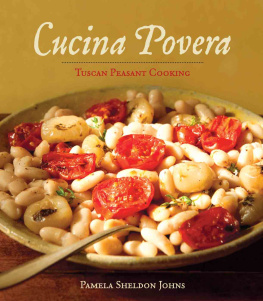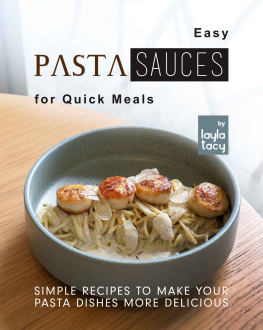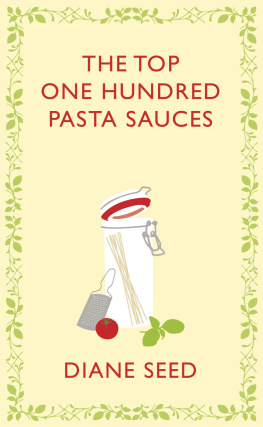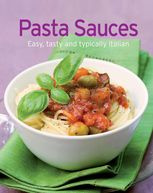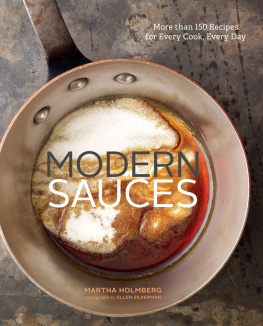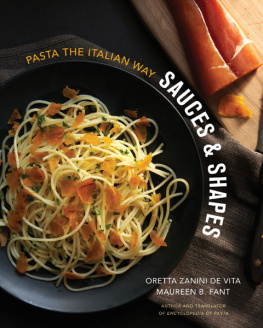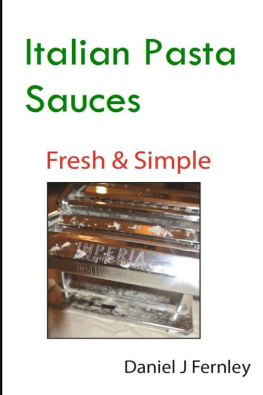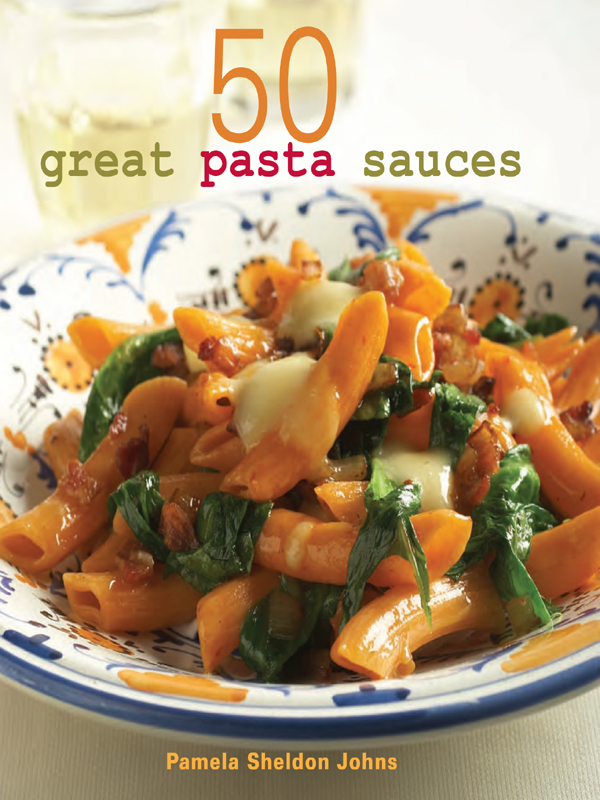
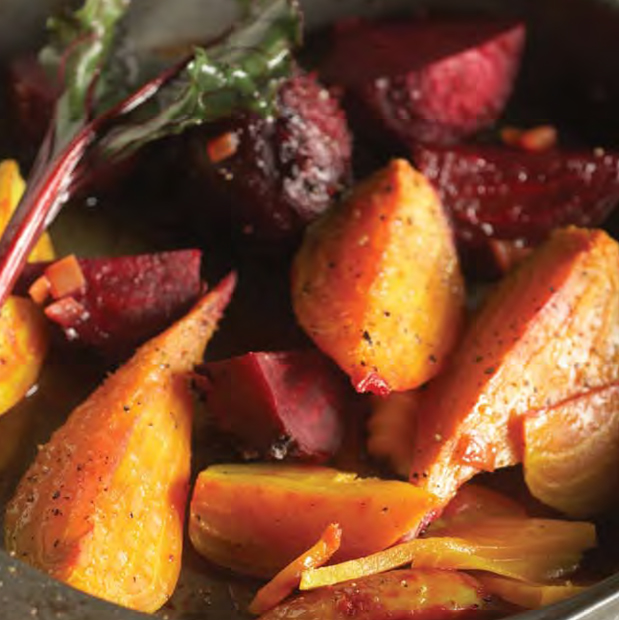
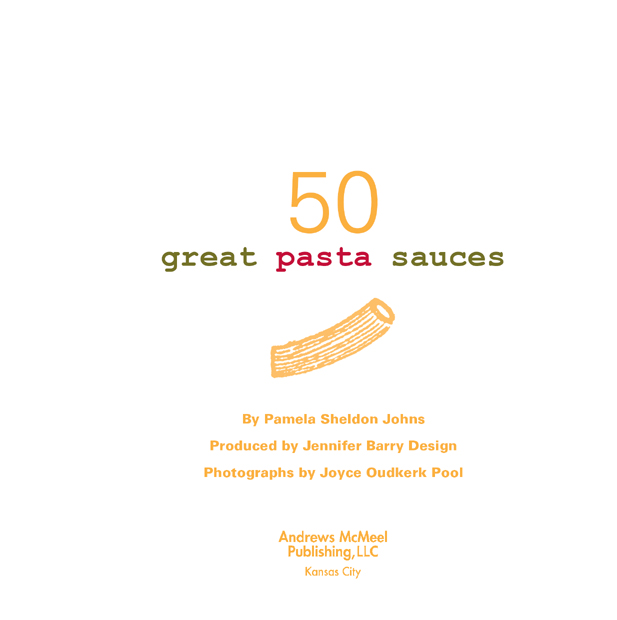
50 Great Pasta Sauces copyright 2006 by Pamela Sheldon Johns and Jennifer Barry Design.
Photographs copyright 2006 by Joyce Oudkerk Pool.
All rights reserved. Printed in Singapore. No part of this book may be used or reproduced in any manner whatsoever without written permission except in the case of reprints in the context of reviews. For information, write Andrews McMeel Publishing, LLC, an Andrews McMeel Universal company, 1130 Walnut Street, Kansas City, Missouri 64106.
Concept and Design: Jennifer Barry Design, Fairfax, California
Production Assistance: Kristen Wurz
Food Styling: Pouk and Dan Becker
Cover photography by Joyce Oudkerk Pool
Cover design by Jennifer Barry
E-ISBN: 978-0-7407-8626-6
Library of Congress Cataloging-in-Publication data is on file.
www.andrewsmcmeel.com
Attention: Schools and Businesses
Andrews McMeel books are available at quantity discounts with bulk purchase for educational, business, or sales promotional use. For information, please write to: Special Sales Department, Andrews McMeel Publishing, LLC, 1130 Walnut Street, Kansas City, Missouri 64106
about italian sauces
It is winter as I write this; outside it is cold and trying to snow, and I am dreaming of the bounty of summer: juicy vine-ripened tomatoes, sweet and crunchy bell peppers, delicate zucchini flowers, and voluptuous eggplants I bundle up and go out to wander nostalgically through my Tuscan orto, the kitchen garden that was and will again be the provider of the products that supply the foundation to garnish our daily staple, pasta. What I find now in my orto is the bounty of winter: garlic, onions, and cavolo nero an almost black kalelike greenstill thriving. I grab handfuls of it and run into the kitchen. In a large pan I pour some of my precious homegrown olive oil and start to brown a little pancetta, onion, and garlic. I chop up the cavolo nero and add it, with a little broth to moisten it. Soon the house is redolent of sweet and piquant aromas. A pinch of peperoncino and a few of the piennolo tomatoes that have been hanging since September, slightly dehydrated and still so sweet, and suddenly I am willing to wait for summer.
In Italy, the sauce on pasta is an accessory, the embellishment of available seasonal products to enhance what is the fundamental dish of every Italian meal. It could be as simple as a fresh, fruity olive oil and a shaving of Parmigiano-Reggiano cheese, or as complex as a rag that has simmered for hours, but the reality is that sauces are treated as a condiment, measured in moderate quantities. Sauce ingredients are determined by several parameters: geography, climate and seasonal ingredients, economy, and history.
The Republic of Italy is a peninsula surrounded by the Mediterranean Sea. The country is divided into twenty regions that have been united for less than 150 years. Each has a unique cuisine indicated by local agriculture and geography. In the past, before transportation was so extensive, these identities remained distinct. Today, with improved conveyance and the advent of the supermarket, interregional products can be found. Tradition and pride in local products are still maintained, however, and dishes have continued to have a strong regional essence.
From top of the boot to toe, the country has wide geographic diversity. Stretching over seven hundred miles from the Alps in the north to the arid, even subtropic, regions of the south, there are hundreds of miles of coastline and the mountainous regions of the Alps and the Apennines. Microclimates abound, and the composition of soil changes dramatically from the humid and fertile plains in the north to the rich volcanic areas in the south.
In general, in the north, the climate is significantly cooler and more humid. The Padano plain stretches across the top of the country, following the Po River, and is considered the heartland of agriculture. Here there are a wealth of industry and numerous dairies and pork producers. Soft wheat is grown here, as well as rice, sugar beets, and soybeans. Sauce preparations make use of the abundance of dairy products, such as cheese, butter, and cream, and cooler-climate vegetables, such as cardoons, radicchio, and sweet peppers.
In the south, the climate is much warmer and drier, and there is a less complex economy. The growing season lasts longer than in the north, and sun-drenched ingredients, such as tomatoes, garlic, broccoli rabe, and eggplant, are found in the typical dishes there. Hard durum wheat and olive oil are staples. In such historically impoverished areas, the tendency has been toward simpler dishes that dont require as much time in a hot kitchen and that utilize the local staples. We think of tomatoes as the classic Italian sauce, but the introduction of tomatoes from the Americas wasnt until the late 1700s.
Pasta has a long history in Italy. From its origins as a simple, inexpensive food that could nourish peasant workers, pasta has evolved to a high art. In most restaurants, the first course, or primo piatto, is an indication of the quality of the rest of the meal. Its not just pastaits Italys national dish.
As in the sauces and ingredients, there are important regional differences in pasta. Fresh pasta historically predominated northern regions because the climate is right for growing soft wheat. Soft wheat does not have enough protein to create the gluten needed for a pasta strong enough to stand up to the kneading and drying process, whereas in the south, where high-protein semola (semolina), or hard wheat, is grown, the culture of dried pasta has evolved.
Basic dried pasta is, after all, only flour and water. The way those two ingredients are handled can make all the difference in the taste and nutrition of this humble food. Modern industrial methods can produce high volumes of a product that can be found in much of the world, but a few artisanal producers still make it the way it was made in the past. Their secret is in the use of semola, good water, the use of bronze extrusion dies (perforated plates for shaping), and slow air-drying at low temperatures.
Bronze dies give the extruded pasta a rough, porous external surface that helps sauce cling to it. Industrial producers, on the other hand, often use Teflon dies. Teflon is easier to clean and squirts out the pasta at a high speed, resulting in a pasta with a hard, slick finish that doesnt interact with sauces.
Air-drying is likewise important to the flavor of the pasta. Industrial producers flash-dry the pasta in high heat over two to four hours, a process that kills flavor and nutrition. Artisanal air-drying is done in warm rooms with constant air circulation, simulating the historic process of sun-drying over a period of days. Luckily, there are now several artisanal dried paste imported from Italy (see Sources, page 108).
Fresh pasta cooks quickly. Angel hair needs only 30 to 45 seconds, fettuccine will take 1 to 2 minutes, and ravioli need 2 to 3 minutes. Dried pasta takes longer, as it needs to rehydrate. Pasta should not be soft or soggy when served. It should have a slight resistance to the bite; the Italians call it al dente, to the teeth. They believe that pasta cooked al dente is more easily digested and just tastes better.


